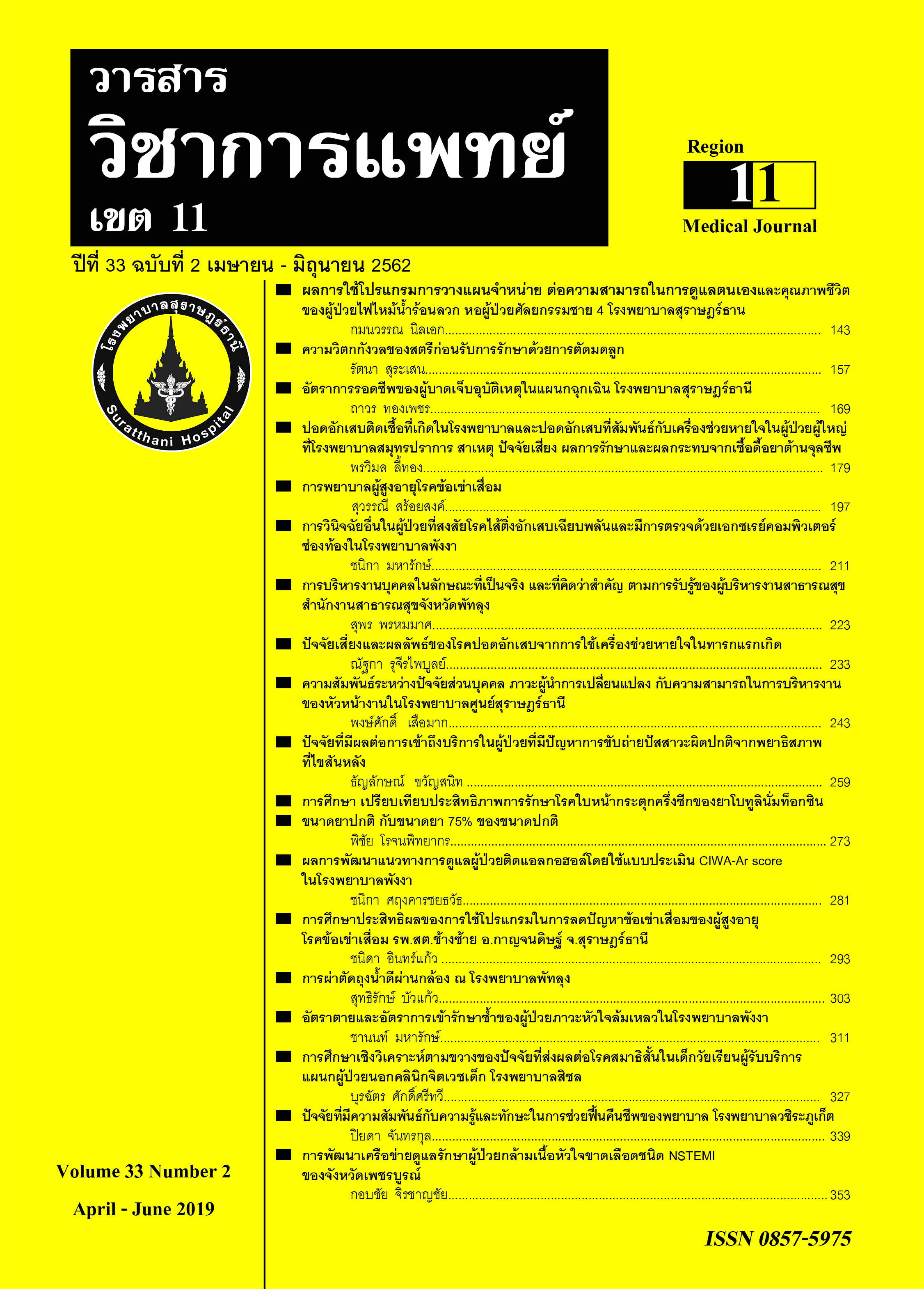Factors associated with Attention Deficit/Hyperactivity Disorders in school aged children of Sichon hospital in crossectional study
Keywords:
ADHD, Sichon hospitalAbstract
Objectives: To study factors associated with Attention Deficit/Hyperactivity Disorders in school aged children of Sichon Hospital
Method: The study was the cross-sectional analytic study conducted by the questionnaires as Self administered questionnaire. The participants of this research are 6-12 years of age, who were diagnosed ADHD and used services in Sichon Hospital .Other groups were children whose ages are between 6-12 years. These children used service in Sichon Hospital.Sample groups were 87 people by Simple Random sampling. The questionnaires were analyzed by using the frequency and finding the relationship of factors associated with Attention Deficit/Hyperactivity Disorders in school aged by using the statistic of Chi-square univariate analysis odds ratio in the level of statistical signficance as p-value < 0.05.
Results: The factors associated with ADHD in school aged children of Sichon hospital were male having risk more 2.7 times than female. Children who were punished by teachers had risk 1.8 times more than the ones who have never been punished by teachers. Children who spent more than two hours a day watching TV had 2.2 times more risk than the ones who spent less than two hours a day. Fathers who graduated lower than secondary school had 2.6 times more risk than the ones who did higher than secondary school. Fathers who used to use drugs had 1.7 times more risks than the ones who have never done
Conclusion: The first factor is sex. The second factor is children who are punished by teacher. The third factor is children who watched TV more than two hours. The fourth factor is children whose fathers graduated lower than secondary school. The fifth factor is children whose fathers used to have drug addicted.
References
2. รัตน์ พมพธ, ดิลก พทว. ปัจจัยที่สัมพันธ์กับโรคสมาธิสั้นในนักเรียนชั้นประถมศึกษา.วารสารการ พยาบาลจิตเวชและสุขภาพจิต (THE JOURNAL OF PSYCHIATRIC NURSING AND MENTAL HEALTH). 2013;27(1):108-20.
3. Association D-AP. Diagnostic and statistical manual of mental disorders. Arlington: American Psychiatric Publishing. 2013.
4. Ketumarn P, Hataiyusuk S, Pornnoppadol C, Apinuntavech S. Prevalence and Factors Associated with Attention-Deficit Hyperactivity Disorder in Male Juvenile Delinquent of Metta Remand Home. Journal of the Psychiatric Association of Thailand. 2016;61(1):27-40.
5. Polanczyk G, de Lima MS, Horta BL, Biederman J, Rohde LA. The worldwide prevalence of ADHD: a systematic review and metaregression analysis.American journal of psychiatry. 2007;164(6):942-8.
6. Pimratana W. Associations between Caretakers’ Attitude, Caretakers’ Knowledge of Attention Deficit Hyperactivity Disorder (ADHD) and Child Patients’ Compliance to Take Methylphenidate (MPH). Journal of the Psychiatric Association of Thailand. 2016;61(1):15-26.
7. ราชวิทยาลัยกุมารแห่งประเทศไทย. คู่มือสำหรับพ่อแม่เพื่อเผยแพร่ความรู้ด้านการดูแลและพัฒนาเด็ก. 2561.
8. พรนภดล ผนช. เด็กสมาธิสั้น; 2560.
9. Association AP. American Psychiatric Association. Diagnostic and Statistical Manualof Mental Disorders, 4thedition; 2000.
10. Szymanski ML ZA. Attention-deficit/hyperactivity disorder: management; 2001.
11. Brassett-Harknett A BN. Attention-deficit/hyper activity disorder: anoverview oftheetiology and a review of the literature relating to the correlatesand
life course outcomes ormen and women.2007;27:188-210.
12. Wacharasindhu A PB. Psychiatric disorders in Thai school-aged children: I Prevalence; 2002.
13. Schweitzer JB CT, Kant CA. Attention-deficit/hyperactivity disorder; 2001.
14. Faraone SV PR, Doyle AE, Smoller JW, Goralnick JJ HM. Molecular genetics of attention-deficit/hyperactivity disorder. Biol Psychiatry; 2005.
15. Mick E BJ, Faraone SV, Sayer J,, S K. Case-control study of attentiondeficit hyperactivity disorder and maternal smoking, alcohol use, and drug use during pregnancy; 2002.
16. A S. Update: attention deficit/hyperactivity disorder in the primary care office; 2005.
17. CastellanosFX LP, SharpW,Jeffries NO, GreensteinDK C. Developmental trajectories of brain volume abnormalities in children and adolescents with attentiondeficit/
hyperactivity disorder; 2002.
18. Krain AL CF. Brain development and ADHD. 2006.
19. Barkley RA FM, SmallishL,Fletcher K. Young adult outcome of hyperactive children: adaptive functioning in major life activities. 2006;45:192-202.
20. Barkley RA F, Smallish L, Fletcher K. The persistence of attention-deficit/hyperactivity disorder into young adulthood as a function of reporting source and definition of disorder. 2002;111:89-279.
21. SR P. Patterns of psychiatric comorbidity with attention-deficit/hyperactivity disorder; 2000.
22. Malek A, Amiri S. Associated factors with attention deficit hyperactivity disorder (ADHD): A case-control study. Archives of Iranian medicine. 2012;
15(9):560.
23. กรมสุขภาพจิต. โรคสมาธิสั้น. In: กระทรวงสาธารณสุข ก, editor; 2016.
24. CORNELL JDUDG. Bullying, Self-Control, and ADHD. 2003;18:129-47.
25. สมาคมจิตแพทย์. เด็กสมาธิสั้น. In: คณะแพทยศาสตร์ศิริราชพยาบาล สภ, editor;2016.
26. Danforth JS, Barkly,R.A.,&Stokes,T.F.Observations of parent-child in teractions with hyperactive children:research and clinical implications. 2001;11:703-27.
27. Malek A, Amiri S, Sadegfard M, Abdi S, Amini S.Associated factors with attention deficit hyperactivity disorder (ADHD): a case-control study.Arch Iran Med. 2012;15(9):560-563
28. Joan Wamulugwa, Angelina Kakooza, Sabrina Bakeera Kitaka, Joyce Nalugya, Mark Kaddumukasa, Shirley Moore, Martha Sajatovic, and Elly Katabira.
Prevalence and associated factors of attention deficit hyperactivity disorder (ADHD) among Ugandan children; a cross-sectional study . Child Adolesc Psychiatry Ment Health. 2016; 11: 18
29. Boonsub Sakboonyarat , Kritchaporn Chokcharoensap, Nadcha Sathuthum. Prevalence and Associated Factors of Attention Deficit Hyperactivity Disorder (ADHD) in a Rural Community, Central Thailand: A Mixed Methods Study. Global Journal of Health Science 2018; 10 (3) :60-69
30. Pisamai Phongsathirat. Factorsassociated with Attention Deficit/ Hyperactivity Disorders in school-age children. The Journal of Psychiatric Nursing and Mental Health 2013:27(1): 108-120
31. Factors associated with attention deficit/hyperactivity disorder among US children: Results from a national survey.Ravi K Lingineni, Swati Biswas, Naveed Ahmad, Bradford E Jackson,Sejong Bae, Karan P Singh Pediatric.2012; 12: 50.
32. Chadapim Sasaluxnanon MD, Titawee Kaewpornsawan MD Risk Factor of Birth Weight below 2,500 Grams and Attention Deficit Hyperactivity Disorder
in Thai Children .Department of Psychiatry, Faculty of Medicine, Siriraj Hospital, Mahidol University. J Med Assoc Thai 2005; 88 (11): 1514-8






